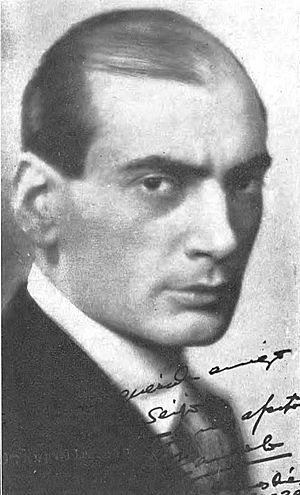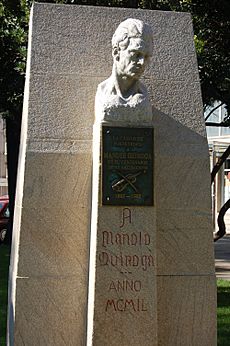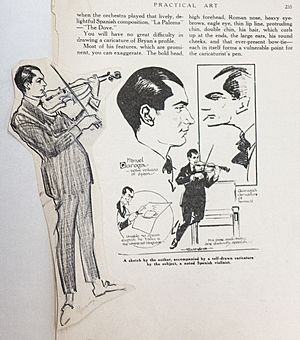Manuel Quiroga (violinist) facts for kids
Quick facts for kids
Manuel Quiroga
|
|
|---|---|
 |
|
| Background information | |
| Birth name | Manuel Quiroga Losada |
| Born | 15 April 1892 Pontevedra, Spain |
| Died | 19 April 1961 (aged 69) Pontevedra, Spain |
| Occupation(s) | Composer, violinist |
| Instruments | Violin |
Manuel Quiroga Losada (born April 15, 1892 – died April 19, 1961) was a very talented Spanish violinist. Many music experts called him "the finest successor of Pablo de Sarasate". Some even called him "Sarasate's spiritual heir".
Famous composers like Enrique Granados and Eugène Ysaÿe wrote music especially for him. Ysaÿe's sixth Solo Sonata for violin is dedicated to Quiroga. Other great violinists like Fritz Kreisler and Jascha Heifetz also admired his amazing skill.
Quiroga was also a composer. He wrote two violin concertos, variations, and smaller pieces for the violin. He was one of the first to use traditional Galician folk music in his classical compositions. Besides music, he was also a gifted artist who drew caricatures and painted portraits.
Sadly, in 1937, Quiroga was in a car accident in New York City. This accident left his arm paralyzed, which ended his career as a performer.
Biography
Early life and studies
Manuel Quiroga Losada was born in Pontevedra, Galicia, Spain in 1892. He started learning the violin with a local amateur teacher named Juan Sayago. Later, he studied with a more skilled teacher, Benito Medal.
Manuel gave his first public concert in 1900 when he was just 8 years old. He performed more concerts in Pontevedra and Santiago de Compostela. In 1904, he received a special grant to study at the Madrid Royal Conservatory. There, he learned from José del Hierro, a leading Spanish violinist. In 1906, a family who admired his talent gave him a valuable 1682 Amati violin.
Manuel also showed his artistic talent early on. In 1907, some of his drawings and caricatures were printed in a magazine called Galicia.
In 1909, he went to Paris with his father. They decided Manuel should try to get into the Conservatoire de Paris, a famous music school. He was the first among hundreds of students to be accepted! He studied there with Édouard Nadaud and Jules Boucherit. He also met and became friends with other famous musicians like George Enescu, Eugène Ysaÿe, and Manuel de Falla.
Starting his career
On July 4, 1911, at 19 years old, Quiroga won the Conservatoire's top prize, the Première Prix nommé. The judges included famous musicians like Gabriel Fauré and Fritz Kreisler. He was the first Spanish violinist to win this prize since Pablo de Sarasate in 1861.
After winning, Quiroga performed as a soloist with famous orchestras. In August 1911, he played a concert in his hometown, Pontevedra, with Enrique Granados on the piano. They became good friends. Quiroga then performed many successful concerts across Spain and France. He often played with other musicians like cellist Juan Ruiz Casaux and pianists José Cubiles and José Iturbi.
In 1913, he signed a contract with a big concert promoter. When World War I started, he was in Austria and was briefly jailed by mistake. The Spanish king, Alfonso XIII, helped him get released. The war stopped his European tours, but it opened doors to the United States.
Quiroga made four very successful tours of the United States and Canada during the war. His first American concert was for 5,000 people in New York. Other great violinists came to watch him play. He refused a fifth tour because his friend Enrique Granados died in 1916. Granados drowned when a German submarine attacked his ship while he was returning from New York.
In 1918–1919, Quiroga toured Spain and Portugal. People in Galicia saw him as their most important artist. He was even made an honorary member of the Madrid Philharmonic Orchestra.
Peak of success
The years between the two World Wars were the best for Quiroga's career. After World War I, he returned to Spain and received a huge welcome in Barcelona. He made his British debut in 1919 and played in famous places like the Wigmore Hall in London. He then performed all over Europe, including Portugal, France, Germany, and Switzerland. His wife, Marthe Lehman, often played the piano for him.
In 1923, Eugène Ysaÿe dedicated his last solo violin sonata to Quiroga. Ysaÿe said he remembered Quiroga's playing style, which reminded him of Sarasate, when he wrote the piece.
Quiroga returned to the United States in 1924. His concerts at Carnegie Hall amazed other violinists. He also played with the famous conductor Arturo Toscanini. Back in Britain, he performed with the London Symphony Orchestra.
On March 31, 1925, Manuel Quiroga performed one of his own major compositions for the first time. It was called Concierto de Intrata. He later renamed it Primer Concierto en el estilo antiguo (First Concerto in the old style). He often played this piece, usually arranged for violin and piano.
He toured South America in 1926, visiting Argentina and Uruguay. Then he went to Cuba, Mexico, and the United States again. In 1928, he made several recordings of short pieces. He also painted a self-portrait in 1930.
He toured America again in 1933 and 1937. He played with pianists Mischa Levitzki and José Iturbi. He also performed with the New York Philharmonic orchestra. In his last tour, he played some of his own new compositions.
Accident and later life
On June 8, 1937, after a concert in New York, Quiroga was hit by a truck while crossing Times Square. He survived, but he slowly lost feeling and movement in his arm. This meant he could no longer perform as a violinist.
He returned to Spain and continued to paint. He entered painting competitions and completed more self-portraits. He also spent time with famous artists and sculptors. In 1940, he drew many caricatures of his friends, including Fritz Kreisler, Pablo Casals, and Arthur Rubinstein.
Quiroga continued to compose music, but later he became ill with Parkinson's disease. He moved back to his hometown of Pontevedra in 1959. He passed away there on April 19, 1961, at the age of 69.
Recordings
Manuel Quiroga recorded many short pieces in 1912 and 1928. He did not record longer works like sonatas or concertos. Many of these recordings are available on a collection called "Great Violinists, Volume 5".
His recordings include music by Albéniz, Falla, Kreisler, and Sarasate. Importantly, he also recorded four of his own compositions: Segunda Guajira, Danza española, Rondalla, and Canto amoroso.
Music written for him
Many musical works were dedicated to Manuel Quiroga, including:
- Enrique Granados: Violin Sonata (one movement)
- Eugène Ysaÿe: Sonata No. 6 for solo violin
- Eduardo Fabini: Fantasía para violin y orquesta
- Joaquín Nin: Sur un air de danse de Pablo Esteve, 1779
- Marcel Samuel-Rousseau: Les Promis
The Spanish writer Ramón del Valle-Inclán also dedicated his poem ¡Del Celta es la Victoria! to Quiroga.
Honours and legacy
The King of Spain honored Manuel Quiroga by making him a Commander of the Order of Alfonso X, the Wise.
On September 24, 1931, the French Government made him a Chevalier de la Légion d'honneur. This is a very high honor in France.
The music school in Pontevedra, founded in 1863, is now called the "Conservatorio Profesional de Musica Manuel Quiroga" in his honor. The street where he was born has also been renamed Calle Manuel Quiroga.
In A Coruña, Galicia, a sculpture was built in his honor in 1950. There is also a memorial bust in Pontevedra. In the city square, there is a full-size statue of him playing the violin to a group of friends.
In 1992, the City Museum of Pontevedra held special events to celebrate 100 years since his birth. They showed his paintings and drawings and held concerts of his music. Quiroga's family had given his music, paintings, drawings, and other items to the museum in 1972.
A Spanish string quartet, the Cuarteto Quiroga, is named in his honor. Since 2014, they have played on valuable Stradivari instruments in Madrid's Royal Palace.
Compositions
Spanish dances
- Canto y danza Andaluza
- Jota nº 1
- Jota nº 2
- Lamento andaluz
- Playera y zapateado
- Rondalla
- Zapateado
- Zortzico
Cuban and Argentine dances
- 1ª Guajira
- 2ª Guajira
- 1ª Habanera
- 2ª Habanera
- 1ª Danza Argentina
- 2ª Danza Argentina
Hymns and songs to Galicia and Spain
- ¡España!
- Galicia
- Alalá
- Alborada
- Emigrantes celtas
- Muñeira
Concertos
- Premier Concierto en el Estilo Antiguo (Concerto Antico I) for violin and chamber orchestra. Also arranged for violin and piano.
- Segundo Concierto en el Estilo Antiguo, for violin and chamber orchestra (only a small part remains)
Other original compositions
- Canto Amoroso
- Viena
- Bruissement d’ailes
- Scherzando
Transcriptions
- Allegrissimo de Scarlatti
- Allegro de Scarlatti
- Andante cantabile de Mendelssohn
Études, caprices and variations for solo violin
- Estudio
- Tres caprichos
- Seis caprichos
- 9 Variations on Caprice No. 24 by Paganini
- 12 Variations on Caprice No. 24 by Paganini
Cadenzas
Quiroga wrote special solo parts (cadenzas) for these concertos:
- Beethoven: Violin Concerto in D major, Op. 61
- Brahms: Violin Concerto in D major, Op. 77
- Mozart: Violin Concerto No. 3 in G major, K. 216
- Mozart: Violin Concerto No. 4 in D major, K. 218
- Mozart: Violin Concerto No. 5 in A major, K. 219
- Paganini: Violin Concerto No. 1 in D major, Op. 6
- Paganini: Violin Concerto No. 2 in B minor, Op. 7
- Cadencia para una fantasía
See also
 In Spanish: Manuel Quiroga Losada para niños
In Spanish: Manuel Quiroga Losada para niños




